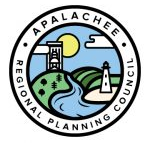ARPC staff continues to work with local stakeholders to move forward. A meeting was held in June 2018 to discuss updates. This meeting was attended by representatives from over a dozen private and public stakeholder groups. ARPC staff is collaborating with Florida Department of Transportation (FDOT) staff to develop criteria needed to utilize the rest area on I-10. ARPC staff will be working with Torreya Park staff to potentially integrate the C2B Trail into the Park’s Unit Management Plan. One of the most common takeaways from this meeting is the complexity of the proposed trail and the number of moving parts. ARPC hopes to continue to facilitate this trail into actuality.
The Feasibility Study found that the C2B Trail is certainly possible. There are many obstacles but no dead ends.
The text below was shared at the June Meeting:
C2B Trail – The Good News
1.) The Apalachee Regional Planning Council completed in 2017 a study of the potential development of the Chattahoochee-to-Bristol Trail in Gadsden and Liberty counties. The completed study noted:
“If developed, the Chattahoochee to Bristol Trail is a major step in uniting regional cultural, historical, and recreational assets through ecotourism. The proposed C2B Trail would follow, where feasible, the eastern bank of the Apalachicola River, traversing both private and public lands in Gadsden and Liberty counties.” and that,
“The initial preferred trail alignment is not necessarily static, and there is the possibility that the trail’s alignment may alter over time as more preferential lands and easements become available.”
“Larger landowners would include The Nature Conservancy, Apalachicola River Timberlands, LLC., the Northwest Florida Water Management District, the City of Chattahoochee, and Torreya State Park.”
Nevertheless, the C2B Study articulated an intention of the Trail was to:
“To provide the most scenic vistas and landscapes, the trail seeks to follow the topography of bluffs and ravines of the Apalachicola River where possible.”
2.) A further result of the study was to propose that the C2B hiking trail be included on to the Florida Department of Environmental Protections, Greenways and Trails System Planning “Opportunity Map” which was being updated in 2017. This was accomplished in September of 2017. The C2B Trail segment is now included on the FDEP Greenways and Trails System Plan’s Land Trail Opportunities Map. “Land Trail Opportunities of the FGTS are corridors which represent existing, planned and conceptual non-motorized multi-use trails. These corridors form a land-based trail network of regional and state importance.”
Moving forward, OGT further refines the Land Trail Opportunity map to identify Ready Land Trail Opportunities. To be recognized as a Ready Opportunity Corridor the trail must meet these criteria to the greatest extent possible:
• Crosses or has the potential to cross county boundaries
• Documented evidence of local or regional government endorsement
• Leads to or connects to a destination which provides scenic qualities and diverse experiences
• Provides access to conservation lands, historic, recreational or cultural sites
• Supports the Florida Ecological Greenways Network (FEGN)
3.) IMPORTANT SIDE NOTE from the C2B Study:
“The C2B trail was considered on its own merits with no direct links to Florida National Scenic
Trail (FNST) routing. The U.S. Forest Service manages the FNST and is studying opportunities for
potential adjustments to the current routing.”
4.) 2018 Florida Forever Five-Year Plan/Florida Forever Land Acquisition Priority List/2018-2019 was approved for the Upper Apalachicola River Ecosystem – 37,895 acres in Calhoun, Liberty, Gadsden, Gulf and Jackson counties. The acquisition of this land would be of great merit to the proposed trail. Large tracts of land included in the routing options between Torreya State Park tracts as well as north of the I-10 rest stop are included in this potential deal.
Apalachicola River Timberlands Map
